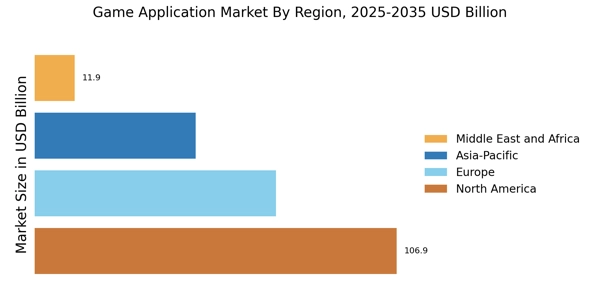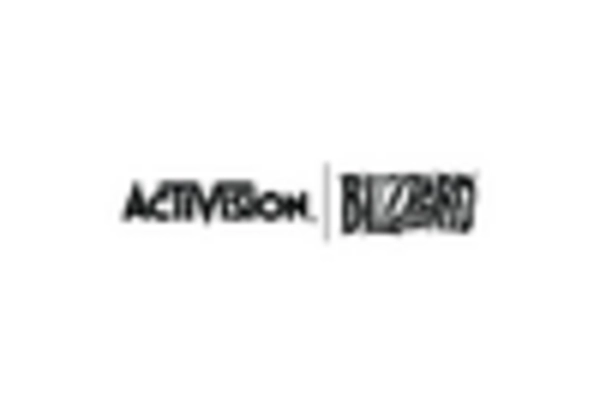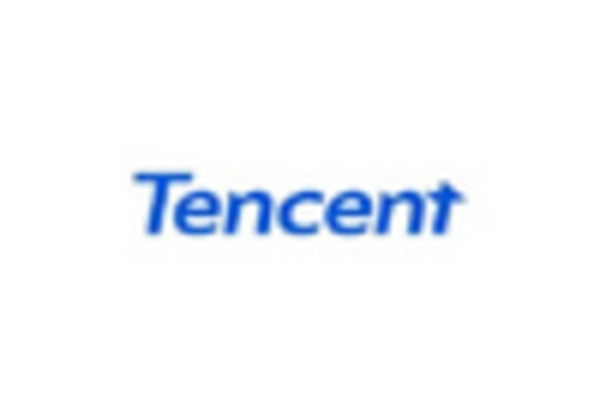Growth of Esports
The Game Application Market is witnessing a remarkable surge in the popularity of esports, which has transformed gaming into a competitive and spectator-driven activity. As of 2025, the esports market is projected to reach a valuation of over 1 billion USD, driven by sponsorships, advertising, and ticket sales. This growth is indicative of a broader acceptance of gaming as a legitimate form of entertainment. The rise of esports has prompted game developers to create applications that cater specifically to competitive play, enhancing user engagement and retention. Furthermore, the integration of live streaming platforms has allowed gamers to showcase their skills, thereby attracting a larger audience and increasing the visibility of the Game Application Market.
Rise of Mobile Gaming
The proliferation of smartphones has catalyzed the expansion of the Game Application Market. As of 2025, mobile gaming accounts for approximately 50% of the total gaming revenue, indicating a substantial shift in consumer preferences. The accessibility of mobile devices allows users to engage with games anytime and anywhere, fostering a more immersive experience. This trend is further supported by the increasing availability of high-speed internet, which enhances online gaming capabilities. Additionally, the introduction of 5G technology is expected to bolster mobile gaming experiences, enabling smoother gameplay and higher-quality graphics. Consequently, developers are increasingly focusing on mobile platforms, leading to a surge in innovative game applications tailored for mobile users.
Increased Investment in Game Development
The Game Application Market is experiencing a surge in investment, which is driving innovation and the development of new applications. As of 2025, venture capital funding for gaming startups has reached unprecedented levels, with investments exceeding 4 billion USD. This influx of capital is enabling developers to explore new ideas, technologies, and business models, fostering a competitive landscape. The increased investment is also leading to the emergence of indie developers who are creating unique and diverse gaming experiences. Furthermore, established companies are expanding their portfolios through acquisitions and partnerships, which is likely to enhance the overall quality and variety of games available in the market. This trend suggests a vibrant future for the Game Application Market, characterized by creativity and innovation.
Social Connectivity and Multiplayer Features
The Game Application Market is increasingly characterized by the emphasis on social connectivity and multiplayer features. As of 2025, approximately 70% of gamers prefer applications that offer social interaction, indicating a shift towards community-driven gaming experiences. This trend is fueled by the desire for collaboration and competition among players, leading to the development of games that incorporate social elements such as chat functions, leaderboards, and cooperative gameplay. The rise of social media platforms has further facilitated this trend, allowing players to share their gaming experiences and connect with others. Consequently, game developers are prioritizing the integration of social features in their applications, which is likely to enhance user engagement and retention in the Game Application Market.
Advancements in Augmented and Virtual Reality
The integration of augmented reality (AR) and virtual reality (VR) technologies is reshaping the Game Application Market. As of 2025, the AR and VR gaming segment is expected to grow at a compound annual growth rate (CAGR) of over 30%. This rapid growth is attributed to the increasing demand for immersive gaming experiences that AR and VR can provide. Developers are investing heavily in creating applications that leverage these technologies, offering users a unique blend of real-world interaction and digital gameplay. The potential for AR and VR to enhance storytelling and user engagement is significant, suggesting that these technologies will play a crucial role in the future of the Game Application Market.


















Leave a Comment